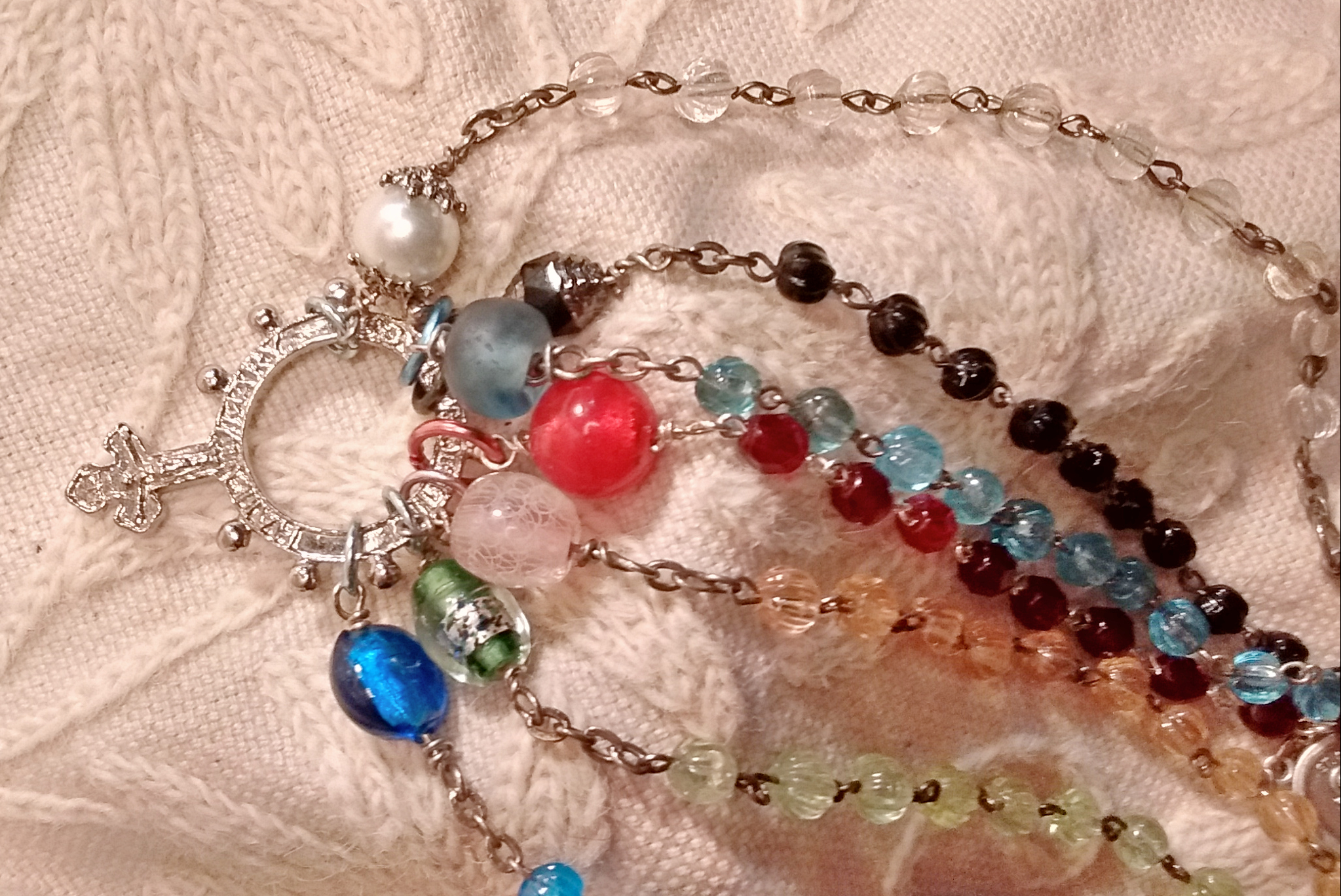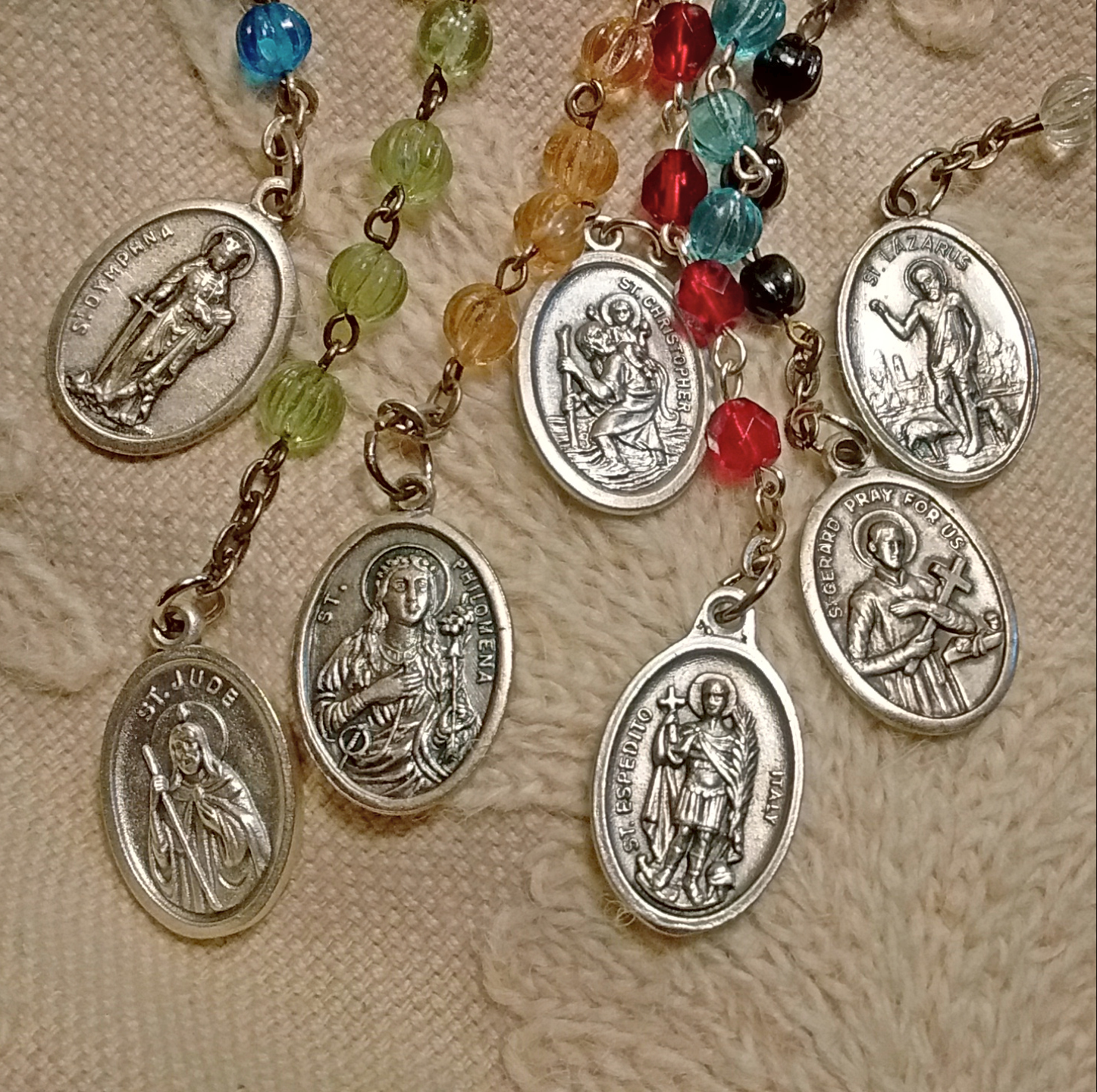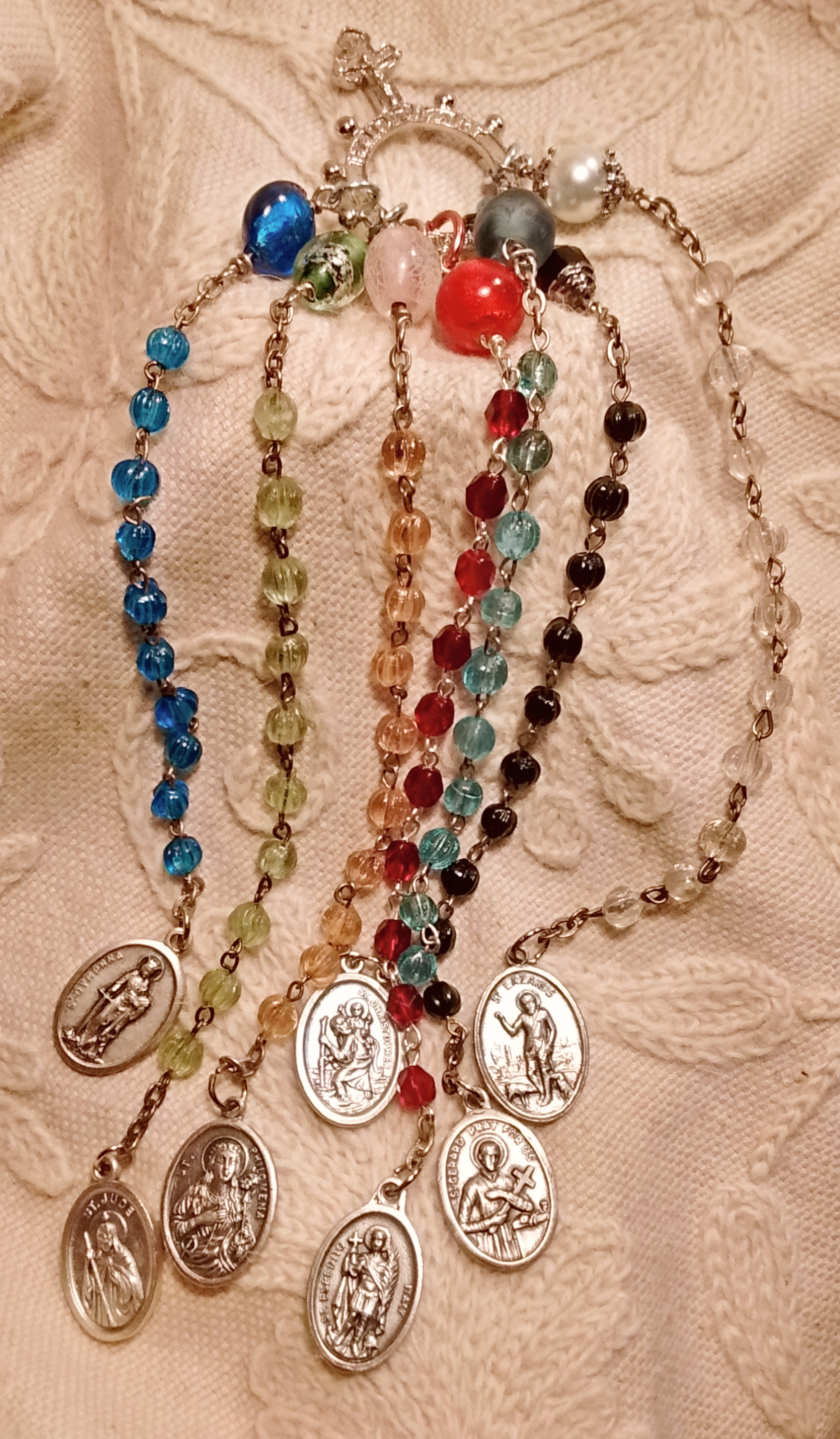


Available through Seraphin Station, this rosary is handmade with a mix of pressed glass and Czech glass beads, each decade being separately attached to the center ring -- a finger rosary -- and embellished with a focal Pater bead of pressed glass, Czech glass, or in one case recycled sandcast glass. Whether you want to see this as a charm collection on a charm hanger displaying seven individual chaplets or single-decade rosaries, or as a sort of deconstructed All Saints' rosary for contemporary rootworkers, this is a striking and unusual piece created by a rootworker with over 35 years of experience working with the roots, rosaries, and these saints in the folk Catholic tradition.
Large, sturdy, colored aluminum jump rings connect each decade to the center ring, so it's possible, should you ever want to, to remove the individual decades and treat them as separate single-decade chaplets. This could be useful if you are working intensively with one or some but not all of these saints or if you're traveling and need to cut down on how much spiritual stuff you're lugging around.
Saints are chosen for their importance in the spiritual landscape of deep South hoodoo rootwork, with an eye towards popularity and contemporary usage (in the sense that while 100 years ago, St. Dymphna was probably not petitioned so often in conjure, today she is an enormously popular saint invoked by folks from all kinds of backgrounds and in all kinds of folk belief contexts. So she's here!)
It's made with strands or decades for the following:
- St. Gerard, patron of pregnancy and childbirth in the Catholic tradition, also represents Baron Samedi of Haitian vodou in some houses and temples. He is the patron of communication with the ancestors and the dead. On the other side of this medal is Our Lady of Perpetual Help pictured with Christ and the angels Michael and Gabriel. OL of Perpetual Help is called on for all kinds of things - in hoodoo in my region, it's often against sickness, income uncertainty, hunger, and unstable households. She's known to help with all of those things. She's also associated in some houses and temples with the lwa Erzulie Danto.
- St. Lazarus is the patron saint of lepers and against leprosy, and by extension against plague and pandemic in contemporary practice. He's also sometimes invoked by beggars, the homeless, people with HIV/AIDS, people with Hansen's disease, and those who have unusually close relationships with dogs. He represents the lwa Legba, the patron of Yoruban divination and master of the crossroads, in many temples and houses, so he's a powerful ally in road opening work.
- St. Expedite is the patron saint invoked for fast luck, for help breaking through obstacles, for help with procrastination, and, increasingly, in desperate cases, much like St. Jude. He's also the patron of computer programmers. In some regions and in some houses, he's associated with the Ghuede lwa who rule the crossroads between life and death, esp. Baron Samedi.
- St. Jude, the patron invoked for hopeless causes, is also called on more generally in conjure for financial prosperity and stability and is a good ally for those whose livelihoods involve working with emotional clients/customers and whose incomes can fluctuate for a host of reasons.
- St. Christopher is the patron saint of travelers, children, and boat captains, invoked for safe travel. In some houses in New Orleans Voodoo, in which Santeria has had a noticeable influence, he is associated with the orisha Agayu. He presents his devotees with difficult obstacles but also grants them the inner power to overcome those trials and grow strong enough to carry all burdens.
- St. Philomena is widely considered a miracle worker invoked by devotees for all kinds of things when other measures have failed. She's the patron of babies and children and is considered the patroness of the living rosary. In some houses and temples, she is a lwa in her own right, seen as a helpful and pleasant spirit who helps those who make their livings as market sellers, removes negativity and evil from the surroundings, and grants the ability to have prophetic dreams.
- St. Joseph is the patron saint of happy death, carpenters, stepfathers, and workers more generally, invoked in all kinds of situations to do with the financial wellbeing of a family and/or household, but especially petitioned by those seeking employment. He's also called on by folks who need to sell their house. He's associated with the lwa Papa Loko, the originary houngan and healer. St. Dymphna is on the reverse side of this medal. She is widely invoked against mental illness, anxiety, and depression, and she's the patron of incest survivors and teenage runaways.
Some of these associations vary by region and the religious background of the practitioner, so I don't mean to imply here that most modern rootworkers work with St. Gerard because of his association with a particular lwa in Haitian sevis. Most rootworkers do no such thing. Hoodoo and vodou are of course two distinct traditions, the former being folk magic and the latter being a religion. In Louisiana, though, especially New Orleans and surrounding areas, there is a strain of practice where the two are often blended to a greater extent than elsewhere as a result of the city's unique history.
I make my esoteric and hoodoo rosaries based in the traditions from the region where I grew up and learned the tricks and tools of the trade (the Gulf Coast of Alabama, with relatives all along the coast from Florida to Texas and a paternal family that had been in New Orleans for six generations before an ancestor relocated to Alabama to seek his fortune in the port of Mobile). This area was much more heavily influenced by Catholicism and saw a much greater percentage of old-school workers who worked with the saints than is typical in other regions. So my hoodoo has lots of saints in it and more than a little influence from the Caribbean.
Furthermore, in the work of occultist, author, and Old Catholic bishop Reverend Dr. Tau Michael Bertiaux, author of the Voudon Gnostic Workbook, Vudu Cartography, and the unpublished Monastery of the Seven Rays material, the systems of hoodoo and Haitian vodou are blended into a dynamic system that offers step by step instruction to the practitioner who seeks access to the Gnosis by means of esoteric prayer. Ultimately, this set of handmade rosary beads is a product of the place where Louisiana culture and tradition meet Franco-Haitian Gnostic Voudon to create good old Big Lucky Hoodoo.
Sometimes called a "medium's necklace" among folks who do this kind of work in this region, this set of beads is ritually created, consecrated, anointed, and censed on seven different altars by a fully consecrated bishop and exorcist in a Gnostic Voudon lineage of apostolic succession (me), and empowered to assist the practitioner in his or her work as a rootworker, serviteur of the spirits, and interpreter of messages from the Invisible World.
You don't have to be Catholic or even Christian to work with the saints in hoodoo, though, fwiw, and lots of folks treat these types of rosaries as ritual items, objects of power, talismans, or pwen cho but do not try to pray the traditional rosary with them. Other folks do use traditional Catholic prayers and practices with my rosaries, or delve into the practices of esoteric Christianity and the traditions of the Seven Rays. And of course it's perfectly fine to just use this as a regular old rosary if you honor and work with the saints but aren't interested in the rootworking and esoteric side of things. There's more info about all of this here at the blog, Big Lucky Hoodoo, if you're interested in learning more. Follow the esoteric prayer tags.
Bishop Tau Michael Bertiaux says of the rosary, in his chapter on Upadhi I in the Voudon Gnostic Workbook, that prayer beads are among the most effective ways to generate spiritual energy and "hook up" to God energy. He conceives of the rosary as a "prayer machine" and emphasizes that the rosary is further blessed and empowered through use. I have blessed and empowered this rosary, but it will absorb deeper spiritual energies through your repeated use.
From top of finger rosary to bottom of medal on longest decade, piece measures 8.75 inches.
